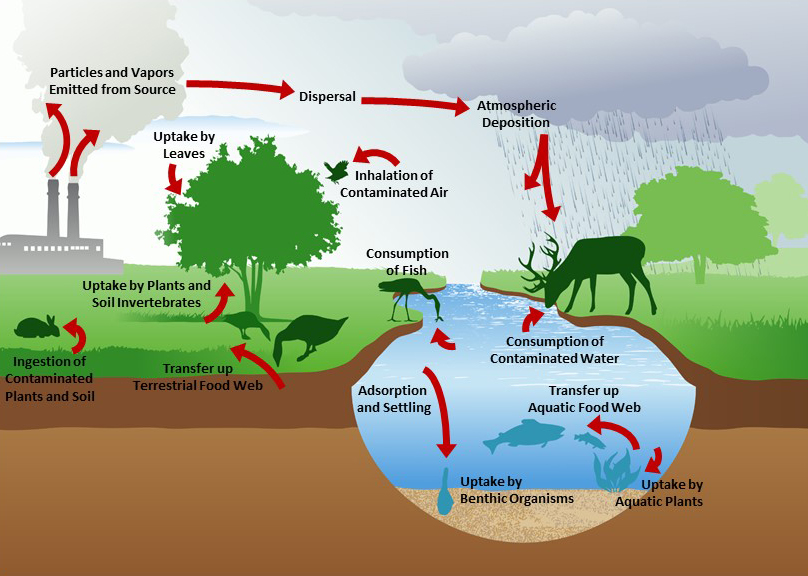EPA EcoBox Tools by Exposure Pathways - Exposure Pathways In ERA
Planning and Problem Formulation Phase: Identifying Pathways of Potential Concern
An exposure pathway defines the process by which a stressorAny physical, chemical, or biological entity that can induce an adverse response (synonymous with agent). may come in contact with receptors. According to U.S. EPA’s Guidelines for Ecological Risk Assessment (1998), in describing the exposure pathway, the assessor traces the paths of stressors from the source(s) to the receptors. A complete picture of how, when, and where exposure occurs or has occurred is developed by evaluating sources and releases, the distribution of the stressor in the environment, and the extent and pattern of contact or co-occurrenceExposure that is not the result of direct contact with a stressor, but occurs when a stressor, due to its spatial or temporal proximity to a receptor, results in significantly altered receptor response..
During the planning and problem formulation phase, exposure pathways of potential concern are identified based on analysis of stressor release, migration, and fate. For an exposure pathway to be complete, a stressor must be able to travel from the source to ecological receptors and to be taken up by the receptors via one or more exposure routes. Identifying complete exposure pathways prior to a quantitative evaluation of toxicity allows the assessment to focus on only those stressors that can reach ecological receptors (U.S. EPA OSWER, 1997).
In evaluating potential exposure pathways, an assessor might consider air, soil, water, sediments, and biota. Exposure could be the result of direct contact with contaminated media (via ingestion, inhalation, and/or dermal contact) or exposure through the food chainA food chain is formed as one organism eats another. A food web is a system of interlocking and interdependent food chains, in which each organism supplies energy to another life form. (U.S. EPA, 1991).
According to U.S. EPA’s Guidelines for Ecological Risk Assessment (1998), determining how a stressor is likely to come in contact with and affect possible receptors forms the basis for developing conceptual models and selecting assessment endpoints. A conceptual model in problem formulation is a written description and visual representation of predicted relationships between ecological entities and the stressors to which they may be exposed.
The figure below is an example for an ecological risk scenario involving multipathway exposure to air pollutants.

Analysis Phase: Characterizing Complete Exposure Pathways
During the analysis phase—which comprises exposure assessment and effects assessment—exposure pathways are characterized. There are five elements of an exposure pathway (U.S. EPA Region 3, Undated; U.S. EPA, 1998):
- Source—how the stressor(s) enter the environment. A source significantly influences where and when stressors eventually will be found. Spatial and temporal distribution of stressors in the environment and transport pathways are parts of source characterization. See the Stressors Tool Set for tools to identify and evaluate ecological exposures to various types of stressors.
- Media—where a stressorAny physical, chemical, or biological entity that can induce an adverse response (synonymous with agent). moves from its source (air, soil, and/or water).
- Exposure—where receptors contact the media.
- Exposure Route—how the stressor(s) enter the receptor’s body (ingestion, inhalation, dermal).
- Receptor—which plants and/or animals are exposed or potentially exposed.
These five elements must be present for an exposure pathway to be complete; otherwise, a pathway is incomplete and there is no exposure.
The final product of these steps is an exposure profile. The exposure profile identifies receptors, describes the exposure pathways, characterizes the intensity and spatial and temporal extent of co-occurrenceExposure that is not the result of direct contact with a stressor, but occurs when a stressor, due to its spatial or temporal proximity to a receptor, results in significantly altered receptor response. or contact, describes the impact of variability and uncertaintyUncertainty represents a lack of knowledge about factors affecting exposure or risk and can lead to inaccurate or biased estimates of exposure. The types of uncertainty include: scenario, parameter, and model. on exposure estimates, and reaches a conclusion about the likelihood that exposure will occur. Compiling the exposure profile helps to ensure that the information needed for risk characterization has been collected and evaluated (U.S. EPA, 1998).
Risk Characterization: Quantifying Risks Associated with Complete Exposure Pathways
The risk characterization quantifies the links between exposure to stressors and effects among ecological receptors. It characterizes the types, extent, and severity of those risks. Completing risk characterization allows risk assessors to clarify the pathways between stressors and receptors and to reach conclusions regarding the occurrence of exposure and the adversity of existing or anticipated effects (U.S. EPA, 1998).
References
- U.S. EPA. (1991). ECO update, volume 1, number 2 (8 pp, 201 K, About PDF) [EPA Report]. Office of Solid Waste and Emergency Response.
- U.S. EPA. (1994). ECO update, volume 2, number 3 (14 pp, 151 K, About PDF) [EPA Report]. Office of Solid Waste and Emergency Response.
- U.S. EPA. (1997). Ecological risk assessment guidance for superfund: Process for designing and conducting ecological risk assessments - Interim final [EPA Report]. (EPA/540/R-97/006). Office of Solid Waste and Emergency Response.
- U.S. EPA. (1998). Guidelines for ecological risk assessment (188 pp, 629 K, About PDF) [EPA Report]. (EPA/630/R-95/002F). Washington, DC: U.S. Environmental Protection Agency, Risk Assessment Forum.
- U.S. EPA. (1999). Data collection for the hazardous waste identification rule.
- U.S. EPA. (2000). Bioaccumulation testing and interpretation for the purpose of sediment quality assessment, status and needs (157 pp, 476 K, About PDF) [EPA Report]. (EPA-823-R-00-001).
- U.S. EPA. (2010). TSCA new chemicals program (NCP) chemical categories [EPA Report].
